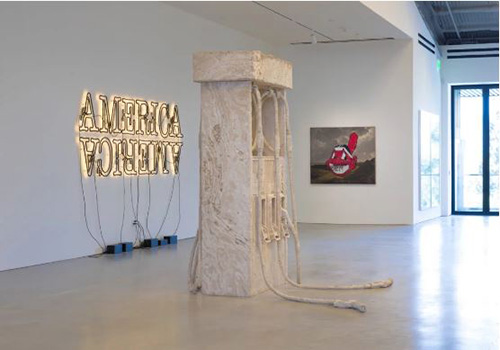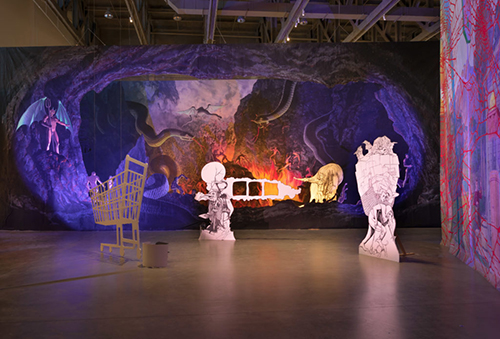Why the Marciano Foundation Embodies the Existential Crisis Facing All
Private Museums
The foundation, which opens in Los Angeles this week, is torn between consensus taste and the eccentricity of its founders.
Installation shot of "Jim Shaw: The Wig Museum".
Photo by Robert Wedemeyer, image courtesy of Marciano Art Foundation, 2017.
When the Marciano Art Foundation opens to the public in Los Angeles tomorrow, May 25, visitors will find many elements born of thoughtful consideration and tremendous passion: A former Scottish Rite Masonic Temple gorgeously renovated and repurposed by Kulapat Yantrasast of wHY Architecture and Design; more than 55,000 square feet of exhibition space that often wisely embraces the arcadian surroundings of Hancock Park; and selections from a more than 1,500-piece contemporary art collection assembled in the span of just over 10 years.
But visitors will also find something never intended by either Maurice and Paul Marciano, the brothers who co-founded the GUESS fashion brand, nor their architectural and curatorial collaborators on the art space now that now bears the Marciano name: an allegory for the current state of the private art foundation, and the contemporary art world more broadly.
Cultural entities like the Marciano Art Foundation (MAF)—free to enter with advance reservations (albeit already booked until July)—have never been more pertinent than they are today. A 2016 report by the collector-tracking platform Larry’s List found 317 “privately founded contemporary art museums” worldwide, 43 of which were in the US. And with wealth continuing to aggressively snowcap the economic mountaintop, the MAF would hardly be the only addition to an updated version of this study.
Maurice Marciano (left) and Paul Marciano at the 2017 MOCA Gala on April 29, 2017 in Los Angeles.
(Photo by Donato Sardella/Getty Images for MOCA.)
Strange as it sounds, though, there’s an argument that the MAF, as currently installed, embodies two opposing models for what a 21st-century private art foundation can be. Much of “Unpacking,” the inaugural exhibition of the foundation’s collection by guest curator Philipp Kaiser, feels as though it could appear in almost any of the 43 other spaces mentioned above. For all their beauty, brightness, and polish, the third-floor galleries hosting the majority of the show also feel safe and expected—at least, when evaluated in a vacuum.
Included in these spaces are multiple works by Christopher Wool, Takashi Murakami, Sterling Ruby, Mark Grotjahn, Albert Oehlen, and Glenn Ligon. Visitors can also find all of these artists a few miles away, inside Eli and Edythe Broad’s private museum—an institution that, like many of its single-donor peers, often seems about as intent on eliminating surprises as the lead nurse in a heart-attack ward. Especially unhelpful: Examples of Ligon’s Double America neon works are installed in both the MAF (a 2012 piece) and the Broad (a 2014 version) concurrently.
 Installation view, including (from left) Glenn Ligon’s Double America (2012), Allora & Calzadilla’s Petrified Petrol Pump No. 2 (2010), Cyprien Gaillard’s Untitled (2012). Photo by Robert Wedemeyer, image courtesy of Marciano Art Foundation, 2017.
Installation view, including (from left) Glenn Ligon’s Double America (2012), Allora & Calzadilla’s Petrified Petrol Pump No. 2 (2010), Cyprien Gaillard’s Untitled (2012). Photo by Robert Wedemeyer, image courtesy of Marciano Art Foundation, 2017.
However, a little research reveals this initial feeling of déjà vu to be misleading. According to William Poundstone, out of over 200 artists in the MAF’s collection, only 39 are also held by the Broad.
The two collections don’t just feel deceptively redundant right now because “Unpacking” includes the work of so many of these shared artists. The sensation also persists because “Unpacking” includes so many works, period. Fairly or unfairly, the sometimes-overhung spaces read as a reflection of anxiousness to verify that the MAF is flush with 2017’s alleged must-haves—the cultural equivalent of wrapping both forearms in Rolexes to ensure every wandering eyeball registers your status.
But after talking to Maurice Marciano—whose 2012 retirement has at least temporarily made him the foundation’s chief steward while his younger brother continues in a leadership role at GUESS—my impression is that “Unpacking,” and the third floor especially, do more to distort the foundation’s goals than to clarify them.
Installation view of the Marciano Art Foundation, including, at center, Rirkrit Tiravanija’s Untitled
(Los dias de esta sociedad son, contados/18 de deciembre de 2009). Photo by Robert Wedemeyer, image courtesy of Marciano Art Foundation 2017.
Case in point: When I asked Maurice if he and his brother use art advisors to help build their collection, he replied that they have not for many years. Instead, he described their continual pursuit of “direct communication with the artists and galleries,” along with their intent to guide the MAF’s acquisitions and programming well into the future based on an “emotional impulse.” What animates this impulse are concepts and genuine excitement, rather than trends or peer pressure.
This is why Maurice chafed at my initial use of the word “museum” to describe the MAF. He insists that the designation is too institutional, too formal to capture what he and Paul want to do there. Instead, he kindly but emphatically requested that I substitute “foundation”—a term he feels is amorphous enough to accommodate the “organic” and “flexible” nature of the enterprise.
To extrapolate, the day the MAF calcifies into a more traditional private museum—one with exhibitions scheduled years in advance and a static display of trophies on view—will be the day it betrays both its founders and its reason for being.
Works by Jim Shaw, including 4 Element Wigs (female set) (2012). Installation view.
Photo by Robert Wedemeyer, image courtesy of the Marciano Art Foundation, 2017.
If you look beyond the marquee names on the uppermost level, much of the foundation’s debut programming does, in fact, honor this vision. The ground floor is dominated by Jim Shaw’s “The Wig Museum,” justifiably billed as the artist’s “first comprehensive solo exhibition in Los Angeles.”
Also curated by Kaiser, the show presents everything from a kitschy mini-gallery of faux coiffure, both found and artist-created, to The Issue of My Loins (2015), a wall-sized cutout of Superman’s crotch containing an array of glowing geodes, to five epic painted backdrops selected from the larger trove of Masonic oddity inexplicably left behind by a society dedicated to covering its tracks.
Installation shot of “Jim Shaw: The Wig Museum”. Photo by Robert Wedemeyer, image courtesy of Marciano Art Foundation, 2017.
Even the ground-floor space itself—where 40-foot-high ceilings tower above a still-somewhat-raw former theater—feels more adventurous than the building’s apex. If the third-floor galleries are the immaculate professional prom photos, the first is the bottle your date snuck under the bandstand, and every thrill that followed.
The atrium and second-floor Lodge Gallery sustain the freewheeling vibe. One highlight, the Relic Room, technically doesn’t even contain artworks. Curated by Susan L. Aberth of Bard College, the ritual objects and accessories inside create a fascinating pocket survey of Scottish Rite Freemasonry.
And although it’s nominally part of “Unpacking,” the Lodge Gallery is ruled by Lizzie Fitch and Ryan Trecartin’s “site-reflective” installation Ledge (2014), a room-sized tent-theater overflowing with the duo’s signature Long Island Iced Tea of multi-channel, gender-bending sensory overload.
Ryan Trecartin and Lizzie Fitch’s Ledge (2014). Installation view. Photo by Robert Wedemeyer,
image courtesy of Marciano Art Foundation 2017.
I can’t realistically imagine many, if any, contemporary art museums greenlighting this triple-header in 2017. “The Wig Museum,” Relic Room, and Ledge show the Marcianos gleefully kicking their foundation free of the accessibility concerns of most public museums and the trend-following instincts of most private ones. Instead, what makes these installations unique and valuable is that they feel, to hijack Ben Mauk’s words about Berlin’s Boros Collection, “tailored to the personal and sometimes whimsical aesthetic of” the founders.
In total, then, the MAF’s debut offers two templates for the private art foundation. One is a luxurious monument to consensus taste. The other is a movable feast, constantly reshaped by the distinct personality of its host.
Here’s hoping my instincts are right about which of the two the Marcianos will sustain long term—and that their example will influence more of their collecting peers to follow suit. Because, like it or not, the arc of contemporary art increasingly bends to the will of the few.
https://news.artnet.com/market/new-marciano-foundation-existential-crisis-private-museums-everywhere-971639




